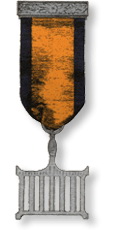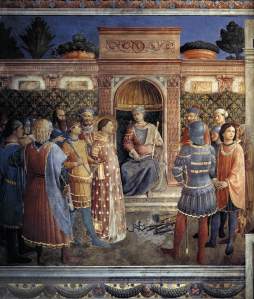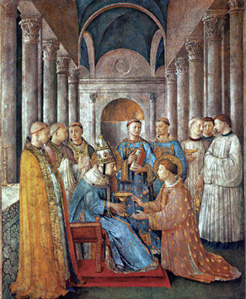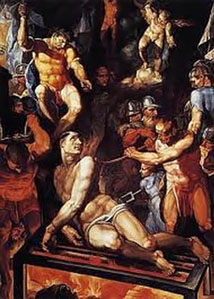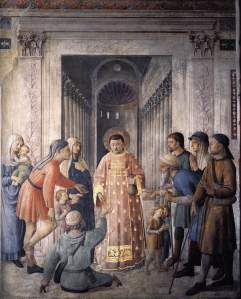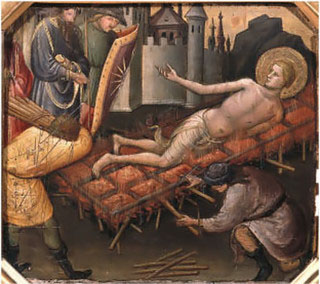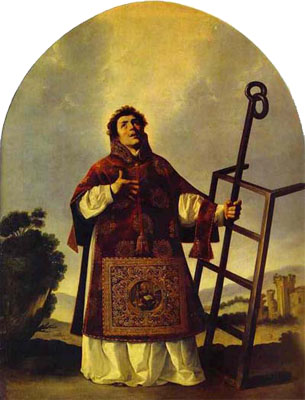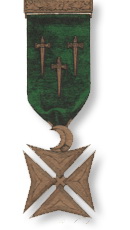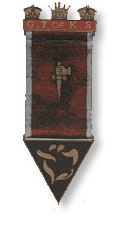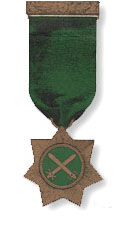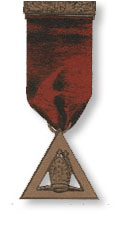An Overview of The Allied Masonic Degrees
St Lawerence The Martyr
The Degree was designed to commemorate the martyrdom of the Saint in Rome in the middle of the third century AD, and teaches the lessons of fortitude and humility.
It is recorded that the Degree has been worked in its present form for over two centuries in Lancashire and Yorkshire. It's been suggested that it was originally a piece of old Operative ritual, intended to distinguish a genuine Craftsman from the "new-fangled" Speculatives when they started to join Craft Lodges.
The Degree of St Lawrence the Martyr is the administrative Degree of a Council. The Master of a Council is elected in a Lodge of St Lawrence, it is the only Installation Ceremony practiced in the Order, and thus becomes the Master of the Council. At every meeting of a Council a Lodge of St Lawrence must be opened and closed. A Lodge or Council of any of the other four Degrees is opened and closed only when the Ceremony of Admission in that Degree is worked.
A Lodge of St Lawrence is arranged like a Craft Lodge, but without candles or Wardens' columns. A Gridiron is placed on the VSL, but the Square and Compasses are not used. Officers are the same as for a Craft Lodge. Ebor Council TI C is unique, we believe, in retaining the office of Keeper of the Gridiron.
Condemnation of St.Lawrence by the Emperor Valerian
FRA ANGELICO St.Sixtus ordains St.Lawrence.jpg
St.Lawrence Distributing Alms
St.Sixtus Entrusts the Church Treasures to Lawrence
The Martyrdom of St Lawrence
Knight of Constantinople
This is a real "side" Degree, in that many years ago, it was customary for one Brother to confer it on another; he would, for example, take him aside at the end of a Lodge meeting, administer a simple obligation and entrust him with the secrets.
The origin of the Degree is not known, but from the strong flavor of Operative influence in the ritual it may be supposed that it arose during the transition from Operative to Speculative Masonry. It is known to have been worked in America in 1831 and may have been taken there by a military Lodge.
The Degree teaches the useful lessons of humility and universal equality.
Grand Tilers of Solomon
This Degree has a legend similar to that of the Cryptic Degree of Select Master, but with interesting variations, in particular with respect to the period of the occurrences. It has also much in common with the Degree of Intimate Secretary (6° of the Ancient and Accepted Rite).
It is known to have been worked in the USA since about 1761 but has not been traced with certainty as having been worked in England before 1893.
The Degree warns of the great danger of carelessness and of hasty judgment and teaches the importance of careful tiling.
The Lodge represents a vaulted chamber in the bowels of the earth beneath the site of King Solomon's Temple.
A candidate in this Degree is said to be "admitted into the Degree of Masons Elect of Twenty-Seven and created a Grand Tiler of Solomon".
The Red Cross of Babylon
The Degree was one of the four Ceremonies which the Grand Council originally took under its control. This, the most profoundly mystical of the Allied Masonic Degrees, is of considerable antiquity. Its three Parts or Points have descended from three of the degrees of Rites worked in the mid-eighteenth century.
The Degree has a complicated, but interesting, history and seems to be linked to many other Degrees in differing Constitutions.
The Degree of the Red Cross of Babylon teaches us to keep inviolate our Masonic secrets and to withstand all temptations to reveal them, however profitable those temptations may be. It emphasises the importance of Fidelity, Integrity, and Truth. It is symbolic of the passage of an upright man from struggles overtime in this world to well-earned honor in the next.
The Holy Order of Grand High Priest
The Holy Order of Grand High Priest, which has been worked extensively in Lancashire and Yorkshire and various other parts of England under the banner of certain Antient Lodges, was one of the four ceremonies which the Grand Council then took under its control. Both in this country and in the US it has always been designated an "Order"; that title, instead of Degree, has been preserved.
Almost everywhere the Order has been closely associated with Royal Arch Masonry. Under the original Constitutions of the Grand Council, no Brother could be admitted to the Order unless he was an Installed Principal of a Royal Arch Chapter. This limitation was removed in 1934 to any Royal Arch Mason. Members of the Order, whether or not Installed Principals, are still designated "Excellent Companions".

